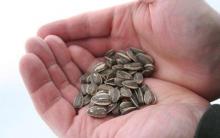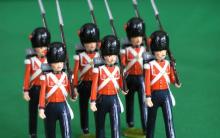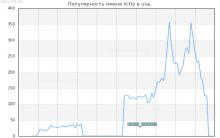June 3, 1867 in Shuisky district, which is Vladimir region Konstantin Balmont was born into a noble family. The poet's mother had a great influence on the future poet.
Balmont was brought up on Russian classics. Reading was his favorite pastime. In 1876, Konstantin entered the Shuya gymnasium, but he was expelled from the gymnasium for illegal activities. The boy barely graduated from the Vladimir gymnasium.
Since 1886, Balmont has been studying at Moscow University at the Faculty of Law. But a year later he was noticed in the unrest of students, spent several days in Butyrka prison, and then was exiled to Shuya. There was another unsuccessful attempt to continue his studies at the Yaroslavl Demidov Lyceum, after which Balmont was engaged only in self-education.
A nervous breakdown, lack of money, a quarrel with my mother over a spontaneous marriage and other troubles seemed unbearable. Konstantin attempted suicide. Having jumped from the third floor onto the pavement, he remained alive, but whole year spent literally chained to the bed.
The poet's first book was published in the same year. The "Collected Poems" aroused great criticism and disapproval from his close comrades. Balmont bought and destroyed almost the entire circulation of the book.
Having rethought his life, Balmont decides for himself that his calling is poetry. He reads a lot, literally “swallows” entire libraries of Russian and foreign literature, studies languages, and does translations. In 1894, a collection of poems, “Under the Northern Sky,” was published.
In 1897, the poet lectured at Oxford. Balmont travels a lot with E. A. Andreeva, with whom he married. The impressions received during his trips to European countries are reflected in his work. Books with his works appear one after another.
The beginning of the twentieth century is marked as the time of Balmont's highest popularity. His influence on young poets is difficult to overestimate. The poet is admired, his books are bought up, they criticize, argue, and imitate his style.
In 1905, Constantine visited the USA and Mexico. After a short stay in his homeland, the poet lived for seven years in Paris. In 1912 Balmont commits trip around the world and only in 1913 he finally finds himself back in Russia. February revolution The poet perceives 1917 and the overthrow of the Tsar enthusiastically, but rejects the October Revolution. In 1921, Balmont and his family left Russia forever.
They live in France. The poet yearns for Russia all the years of emigration.
Konstantin Balmont died at the end of 1942 on December 24 in Paris. The Russian Symbolist poet was buried in the Paris suburb of Nauzy-le-Grand.
Life and art
Early life and education
Konstantin Balmont, a Russian poet and writer, comes from the small village of Gumnishchi, which was located in the Vladimir province. Born on June 15, 1867, he lived with his family in his native village until he was 10 years old. The boy's parents were highly educated and intelligent. To their children they early childhood tried to instill a love of knowledge. Konstantin's father, Dmitry Konstantinovich, received a law degree in his youth higher education. He first worked as a judge, but after moving to Shuya, he began to serve as head of the zemstvo council.
The children began to study at the gymnasium. Here young Balmont felt a craving for literature and art. His mother, Vera Nikolaevna, played a big role in this. Kostya did not have any particular zeal for acquiring knowledge and was a mediocre student. All free time he devoted himself to reading and studying new trends in poetry and literature. The young man was expelled from the gymnasium for participating in revolutionary circles. To continue his studies, he had to move to Vladimir, where he studied until 1886. After the final exams, he submitted documents to Moscow State University, where I was able to study only for a year. On charges of organizing unrest among the student masses, the revolutionary was expelled from the student community and registered at the police station.
Creative path
Konstantin composed his first creations at the age of ten. However, his mother was critical of the poems, and the teenager gave up trying to create something worthwhile for several years. Konstantin gained faith in himself at the age of 18, after a successful publication in the St. Petersburg literary almanac “Picturesque Review”. Upon reaching the age of 20, Balmont discovered his ability to study foreign languages. For several years he translated many works of the poetic genre, but after bad marriage and attempted suicide, he was chained to bed for a long time. Over the course of a year, the poet composed enough poems to combine them into a separate collection. They did not arouse interest among the public, and the author sent the entire circulation for scrap.
In order not to succumb to extensive depression, the aspiring writer reads a lot and studies foreign languages. He managed to translate several serious historical research. The end of the 90s of the nineteenth century marked the peak of Balmont’s creative heyday. He publishes several collections of his poems, which have already had significant success. Having received public recognition, the poet marries a second time and goes on a tour of Europe with his wife.
Konstantin returned to his homeland as a recognized poet. At the beginning of the 20th century, he began to create a fourth book of poetry. It was published in 1903 and was called “Let’s be like the sun.” This work became a cult work and brought the author enormous success. Since 1905, Konstantin Dmitrievich begins to travel around the world, first in Mexico, and then in America.
Since 1920, due to the deterioration of the health of his wife and daughter, the famous poet settled with them in France. In Paris, Balmont published several collections of poetry and autobiographical works. He died on December 23, 1942 in the picturesque town of Noisy-le-Grand, located near Paris.
B almont Konstantin Dmitrievich (1867, June 15, village of Gumnishchi, Vladimir province - 1942, December 23) - Russian poet, translator, essayist.
Born in the village of Gumnishchi, near the city of Vladimir. Father, Balmont Dmitry, was a judge. Mother - Lebedeva Vera, comes from a general’s family, where it was considered the main thing cultural development person. She had a strong influence on Constantine's passion for music and literature.
At the age of five he already knew how to read, which he taught himself. The first poets whose work I became acquainted with were: , . In 1876, the family moved to Shuya, where Balmont studied at the gymnasium. At the age of ten he began writing his own poetry. By that time he had read many books in German and French. In 1884 he was expelled due to his participation in a “revolutionary” circle.
That same year, Balmont moved to the city of Vladimir, where he continued his studies at the gymnasium for two years. In 1886 he entered Moscow University at the Faculty of Law. Konstantin had a rebellious character, and the free atmosphere at the university only strengthened it. He took part in a student revolt against innovations at the university and was soon expelled and spent several days in Butyrka prison. He soon returned to study, but never received a law degree due to loss of interest. He wrote that all the knowledge in the field of literature, history, philosophy, and philology that he received was acquired as a result of self-education. He followed the example of his older brother, who was very interested in philosophy.
1890 Balmont attempts suicide by jumping from a third-floor window. After this, he remained lame for the rest of his life. Apparently, Balmont had a genetic tendency to mental illness. This began to appear in early years the writer's life and had an influence throughout his life. Many historians and biographers believe that Creative skills Balmont was positively affected by his mental disorders.
Balmont's debut as a poet was plagued by many failures. For several years, none of the newspapers agreed to publish his poems. In the end, he decided to do everything himself and published a book of poems in 1890. But the book was not a success; even friends and family did not approve of it. This reaction to his book hurt Konstantin so much that he burned all the copies.
Instead of writing poetry, Balmont focuses on translating the works of foreign poets and writers. He had amazing linguistic abilities, speaking more than ten languages. This gave him the opportunity to read European literature and translate it into Russian. He worked with English and Spanish poetry and translated the works of Calderon, Ibsen, Whitman, Allan Poe and many Armenian and Georgian poets. In 1893 he published translations of all of Percy Shelley's works in Russian. Balmont dealt with works in many other languages: Baltic and Slavic, Indian and Sanskrit.
Working as a translator brought much more fruit than writing poetry. Translations of Edgar Allan Poe's works were published in almost every magazine that was published at the time. This fact gave Balmont the courage to once again try his hand at being a poet. The collections “Under the Northern Sky” in 1894 and “Silence” in 1898 finally brought him the recognition and fame that he had been looking for for so long. In addition to the obvious content, Balmont's symbolist poetry carried a hidden message, expressed through veiled allusions and melodic rhythms of language.
At the beginning of the century, Balmont reached the pinnacle of poetic activity. The books “Let’s Be Like the Sun” and “Only Love” are considered the author’s best creations. He brought moral and almost physical release from traditional gloomy and sad poetry that complained about life in Russia. His proud optimism and life-affirming enthusiasm encourage freedom from the restrictions that society imposes. Balmont's poetry became a new philosophy, marking the beginning of the Silver Age of Russian poetry.
In subsequent works, Balmont changed his writing style to a more aggressive one. Many of his contemporaries took this as a call for revolution. Balmont protested in his works mainly against injustice, but his lifelong rebellion ended with the writing of the controversial poem “The Little Sultan,” in which he criticized Nicholas II, thereby earning discontent with the authorities. Konstantin was expelled from St. Petersburg and received a ban on living in university cities in Russia.
Balmont left the country and became a political emigrant. He enjoyed traveling and used this time to curb his thirst for adventure. It seems that the world has not yet known a poet who spent a lot of time there on the deck of a ship or looking out of a train window. He traveled through Europe, Mexico, Egypt, Greece, South Africa, Australia, Oceania, New Zealand, Japan, India. His contemporaries said that he saw more countries than all other Russian writers combined.
In 1905, Balmont published another book of poems entitled “Liturgy of Beauty.” Critics noticed a deterioration in Balmont's poetic works - he began to repeat his old ideas, images and techniques. His praise of life was no longer perceived convincingly, as if it had been feigned and the author himself did not believe his words.
In 1913, in honor of the three hundredth anniversary of the House of Romanov, all political immigrants were awarded an amnesty and Balmont was able to come to Russia. He was a supporter of the February Revolution in 1917, but was soon horrified by the chaos and subsequent civil war. IN to a greater extent he couldn't agree with new policy aimed at suppressing personality. He received a temporary visa and left Russia forever in 1920.
Balmont and his family settled in Paris. Here he wrote most of his works - about 50 books. Despite this, he best years, as a writer, are long gone, the poems indicated a weakening of creative forces. He did not maintain contact with the Russian emigrant society and lived in isolation from it. Despite this, he was very homesick and the only way to alleviate his suffering was poetry, which he dedicated to her.
After 1930, signs of mental instability began to become more pronounced and his condition began to deteriorate due to poverty, nostalgia and loss of poetry writing skills. Balmont, in fact, went crazy.
Balmont died in Nazi-occupied France at the age of 79 from pneumonia. He was buried in the city of Noisy-le-Grand.
Konstantin Balmont had a huge influence on Russian literature and poetry, freed it from old ideas and introduced new ways of expressing thoughts and ideas.
Balmont Konstantin Dmitrievich (1867 -1942). silver Age lasted in Russia only a couple of pre-revolutionary decades, but gave many bright names to Russian poetry. And for a whole decade Konstantin Balmont reigned on the poetic Olympus.
He was born near Shuya, in the family of a provincial nobleman. He learned to read by attending his mother's lessons, who taught his older brother. His mother shaped the beginnings of Konstantin’s worldview, introducing him to the world of high art.
Studying at the gymnasium ended with expulsion due to the dissemination of Narodnaya Volya proclamations. Nevertheless, he managed to obtain an education (1886), although the poet had painful impressions of this period. Balmont's debut (1885) in a famous magazine went unnoticed; the published collection also did not evoke any response.
The second collection “In the Boundless” (1894) was absolutely noted new form and rhythm. His poems are getting better and better. Having escaped from lack of money, the poet travels, works a lot, and gives lectures on Russian poetry in England. In the collection of poems “Burning Buildings” (1900), readers saw the Balmont who would control the souls of the Russian intelligentsia of the early 20th century.
Konstantin Balmont becomes the leader of symbolism. They imitate him, envy him, and fans try to break into the apartment. The poet, prone to romanticism, took part in the revolution of 1905, because of which he was forced to hide abroad.
Upon returning to his homeland, Balmont published a ten-volume edition of his works. He does translations and lectures. The poet welcomed the February Revolution, but soon lost interest in its slogans. And the revolution of October 1917 caused him to be rejected. Balmont seeks permission to leave and leaves his homeland forever.
In exile, the poet avoids circles hostile to the USSR. There is nowhere to get help. In addition, Balmont supports two families, and the financial situation is becoming more and more difficult. He wrote his last collection of poems, “Light Service” (1937), already suffering mental illness. In recent years, he lived in a charity home, where he died of pneumonia in the winter of 1942.
Konstantin Balmont returned to Russian readers when the first anthologies of poets of the Silver Age were published in the sixties.
Konstantin Dmitrievich Balmont (with the emphasis on the first syllable - a generic name, on the second - a literary name) - Russian poet, prose writer, critic, translator - born June 3 (15), 1867 in the village of Gumnishchi, Shuisky district, Vladimir province, in a poor noble family. Here he lived until he was 10 years old.
Balmont's father worked as a judge, then as head of the zemstvo government. The love of literature and music was instilled in the future poet by his mother. The family moved to the city of Shuya when the older children went to school. In 1876 Balmont studied at the Shuya gymnasium, but soon he got tired of studying, and he began to pay more and more attention to reading. After being expelled from the gymnasium for revolutionary sentiments, Balmont transferred to Vladimir, where he studied before 1886. Studied at Moscow University in the law department ( 1886-1887.; expelled for participating in student riots).
K. Balmont published poetry for the first time in 1885 in the magazine “Picturesque Review” in St. Petersburg. Late 1880s Balmont was engaged in translation activities. In 1890 due to distress financial situation and an unsuccessful first marriage, Balmont tried to commit suicide - he jumped out of the window, but remained alive. Having received serious injuries, he spent a year in bed. This year has been productive in creatively. The first collection of poetry was published in Yaroslavl in 1890(destroyed most circulation).
He gained initial fame as a translator of the works of B.P. Shelley and E. Poe. Balmont has been translating (from more than 30 languages) all his life; his translations of Calderon’s plays and “The Knight in tiger skin» Sh. Rustaveli.
Books of poems “Under the Northern Sky” ( 1894 ) and "In the Vast" ( 1895 ) are close to impressionism, marked by the musical melodiousness of the verse. Having become close to the circle of senior symbolists ( in the mid 1890s., living in Moscow, Balmont communicates with V.Ya. Bryusov, a little later in St. Petersburg - with D.S. Merezhkovsky, Z.N. Gippius, N.M. Minsky), Konstantin Balmont becomes one of the most famous poets this direction.
Getting married for the second time in 1896, Balmont leaves for Europe. He has been traveling for several years. In 1897 in England he lectures on Russian poetry.
A kind of lyrical trilogy are his best collections of poetry - “Silence” ( 1898 ), "Burning Buildings" ( 1900 ) and “Let's be like the Sun” ( 1903 ). Enthusiastic openness to all phenomena of the world, incl. and “demonic” (especially noticeable in the cycle “The Devil Artist” and in the collection “Evil Spells”, confiscated by the censors, 1906 ), ability to record instant experiences, mastery of complex shapes verse, the phonetic richness of speech made Balmont's poems extremely popular.
The books of critical essays “Mountain Peaks” ( 1904 ), "Poetry as magic" ( 1915 ). Readers' admiration was aroused by the poet's knowledge of many languages and multiculturalism, images of exotic countries (K. Balmont visited Mexico, Polynesia, Australia, Japan, etc.), reputation as an active “life creator” (including in personal life, well known to the public).
However, the abundance of travel impressions often interfered with the deep experience of other cultures; in his work they became difficult to distinguish from each other. The profuse writing (voluminous books of new poems were published almost every time) entailed self-repetition, impressionistic descriptions of the nature and soul of the poet became stereotyped. And although some poems and even books were successful (for example, “Liturgy of Beauty”, 1905 ; "Firebird", 1907 ; "Glow of Dawn" 1912 ), criticism increasingly spoke about the decline of K. Balmont’s work. K. Balmont’s biased speeches with political poems did not save the situation. He was persecuted more than once, 1906-1913. he was forced to live abroad (mainly in Paris), but his revolutionary poems (“Songs of the Avenger”, 1907 , etc.) do not correspond to the level of the poet’s talent.
K. Balmont spent the years of the First World War and the Revolution in Russia. In the essayistic book “Am I a Revolutionary or Not” ( 1918 ) asserted the priority of the individual over social transformations. In 1920 because of feeling unwell his third wife and daughter, with the permission of the Soviet government, he went with them to France. He never returned to Russia. In Paris, Balmont publishes 6 more collections of his poems, and in 1923 - autobiographical books: “Under the new sickle”, “Air route”. There he soon came out with sharp criticism of the Bolshevik regime.
In the 1920s and in the first half of the 1930s. Konstantin Balmont continued to publish a lot, wrote poetry and prose, translated Polish, Czech, Bulgarian, Lithuanian poets; during his trips to Europe, his performances were successful, but Balmont no longer enjoyed recognition in the centers of the Russian diaspora.
Since 1937 mentally ill, practically did not write. Konstantin Balmont died of pneumonia December 23, 1942 in Noisy-le-Grand (near Paris) in the Russian House shelter in poverty and oblivion.
Konstantin Dmitrievich Balmont (1867-1942) - Russian poet, prose writer, critic, translator.
Konstantin Balmont was born on June 3 (15), 1867 in the village of Gumnishchi, Shuisky district, Vladimir province, in the family of a zemstvo leader. Like hundreds of boys of his generation, Balmont became carried away by revolutionary and rebellious sentiments. In 1884 he was even expelled from the gymnasium for participating in a “revolutionary circle.” Balmont completed his gymnasium course in 1886 in Vladimir and entered the law faculty of Moscow University. A year later, he was also expelled from the university - for participating in student riots. After a short exile to his native Shuya, Balmont was reinstated at the university. But full course Balmont never finished: in 1889 he quit his studies to pursue literature. In March 1890, he experienced an acute nervous disorder for the first time and tried to commit suicide.
In 1885, Balmont made his debut as a poet in the magazine "Picturesque Review", in 1887-1889. actively translated German and French authors, and in 1890 in Yaroslavl he published the first collection of poems at his own expense. The book turned out to be frankly weak and, stung by the negligence of readers, Balmont destroyed almost its entire circulation.
In 1892, Balmont traveled to Scandinavia, where he became acquainted with the literature of the “end of the century” and was enthusiastically imbued with its “atmosphere.” He began translating the works of “fashionable” authors: G. Ibsen, G. Brandes and others. He also translated works on the history of Scandinavian (1894) and Italian (1895-1897) literature. In 1895 he published two volumes of translations from Edgar Allan Poe. Thus began Balmont’s activity as the largest Russian poet-translator of the turn of the century. Possessing the unique abilities of a polyglot, over half a century of his literary activity he left translations from 30 languages, including Baltic, Slavic, Indian, Sanskrit (the poem by the ancient Indian author Asvaghoshi “The Life of Buddha”, published in 1913; “Upanishads”, Vedic hymns, dramas of Kalidasa), Georgian (the poem “The Knight” by Sh. Rustaveli in tiger skin"). Most of all, Balmont worked with Spanish and English poetry. Back in 1893 he translated and published full meeting works of the English romantic poet P.-B. Shelley. However, his translations are very subjective and free. K. Chukovsky even called Balmont, Shelley’s translator, “Shelmont.”
In 1894, the collection of poems “Under the Northern Sky” appeared, with which Balmont truly entered Russian poetry. In this book, as well as in the collections that were close in time, “In the Boundless” (1895) and “Silence” (1898), Balmont, an established poet and exponent of the life-feeling of a turning point, still gives off “Nadsonian”, Eighties tones: his hero he languishes “in the kingdom of dead, powerless silence,” he is tired of “waiting in vain for spring,” he is afraid of the quagmire of the everyday, which “will lure, squeeze, suck in.” But all these familiar experiences are given here with a new force of intensity and tension. As a result, a new quality arises: the syndrome of decline, decadence (from the French decadence - decline), one of the first and most prominent exponents of which in Russia was Balmont.
Along with A. Fet, Balmont is the most striking impressionist of Russian poetry. Even the titles of his poems and cycles carry a deliberate watercolor blur of colors: " Moonlight", "We walked in a golden fog", "In a soft golden haze", "Airy white". The world of Balmont's poems, as in the paintings of artists of this style, is blurred, disobjectified. It is not people, not things, or even feelings that dominate here , and ethereal qualities formed from adjectives, nouns with the abstract suffix “awn”: fleetingness, vastness, etc.
Balmont's experiments were appreciated and accepted by great Russian poetry. At the same time, by the end of the 1900s they gave birth to an unimaginable number of epigones, nicknamed “Balmontists” and taking their teacher’s magnificent decorativeness to the limit of vulgarity.
Balmont's work reached its zenith in the collections of the early 1900s "Burning Buildings" (1900), "Let's Be Like the Sun" (1903), "Only Love" (1903), "Liturgy of Beauty" (1905). At the center of Balmont's poetry of these years are images of the elements: light, fire, sun. The poet shocks the audience with his demonic pose and “burning buildings.” The author sings “hymns” to vice, fraternizes through the centuries with the villainous Roman emperor Nero. Most of his fellow writers (I. Annensky, V. Bryusov, M. Gorky and others) considered the “superhuman” claims of these collections, alien to the “feminine nature” of the “poet of tenderness and meekness,” to be masquerade.
In 1907-1913 Balmont lived in France, considering himself a political emigrant. Traveled extensively around the world: completed circumnavigation, visited America, Egypt, Australia, the islands of Oceania, Japan. During these years, criticism writes more and more about its “decline”: the factor of novelty of Balmont’s style ceased to work, they got used to it. The poet's technique remained the same and, according to many, degenerated into a stamp. However, Balmont of these years opens up new thematic horizons for himself, turning to myth and folklore. For the first time, Slavic antiquity was heard in the collection “Evil Spells” (1906). The subsequent books “Firebird”, “Slavic Pipe” (1907) and “Green Vertograd”, “Kissing Words” (1909) contain processing of folklore stories and texts, translations of “epic” Rus' into a “modern” way. Moreover, the author pays main attention to all kinds of sorcerer’s spells and Khlyst zeal, which, from his point of view, reflects the “people's mind.” These attempts were unanimously assessed by critics as clearly unsuccessful and false stylizations, reminiscent of the toy “neo-Russian style” in the painting and architecture of the era.
Balmont met the February Revolution of 1917 with enthusiasm, but October Revolution made him horrified by the “chaos” and “hurricane of madness” of the “troubled times” and reconsider his former “revolutionism.” In the 1918 journalistic book “Am I a Revolutionary or Not?” he presented the Bolsheviks as carriers of destructive principles, suppressing “personality.” Having received permission to temporarily go abroad on a business trip, together with his wife and daughter in June 1920, he left Russia forever and reached Paris through Revel.
In France, he acutely felt the pain of isolation from other Russian emigration, and this feeling was aggravated by self-exile: he settled in the small town of Capbreton on the coast of the province of Brittany. For two decades, Balmont the emigrant’s only joy was the opportunity to remember, dream and “sing” about Russia. The title of one of the books dedicated to the Motherland, “Mine is Hers” (1924), is the poet’s last creative motto.
Until the mid-1930s, Balmont's creative energy did not weaken. Of the 50 volumes of his works, 22 were published in exile (the last collection, “Light Service,” was published in 1937). But this did not bring either a new reader or relief from need. Among the new motives in Balmont's poetry of these years is the religious enlightenment of experiences. Since the mid-1930s, signs of mental illness have become increasingly clear, darkening last years poet's life.
Balmont died on December 24, 1942 in Noisy-le-Grand in France, listening to the reading of his poems, in an almshouse near Paris, established by Mother Mary (E. Yu. Kuzmina-Karavaeva).











The benefits of sunflower seeds for the heart, hair and nerves
Why do my legs give way at the knees?
Name energy: how the patronymic influences fate and the birth program Name patronymic meaning character
First Chinese Emperor
Alfred the Great: biography